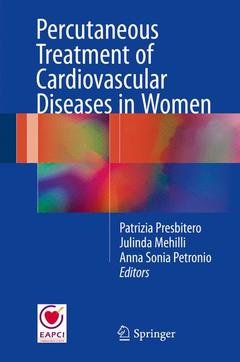Percutaneous Treatment of Cardiovascular Diseases in Women, Softcover reprint of the original 1st ed. 2017
Coordonnateurs : Presbitero Patrizia, Mehilli Julinda, Petronio Anna Sonia

This book describes a wide range of interventional procedures currently employed in the treatment of cardiac diseases in women with the aim of enabling not only interventional cardiologists but also cardiologists and cardiac surgeons to refine their approach to female patients and thus improve outcomes. The book reflects the increasing awareness of gender differences with regard to coronary artery disease and structural valve heart disease. Examples include myocardial infarction, which carries a worse prognosis in women in part because they suffer from this disease mostly in the 7th decade of life, present more frequently with hemodynamic instability and later from symptom onset, and have fragile, small and tortuous coronary arteries that are more technically demanding in the context of primary percutaneous coronary intervention. Another example is symptomatic aortic stenosis, which carries a better prognosis in women who undergo trans-catheter aortic valve implantation partially due to a better annulus-prosthesis match, which leads to less residual paravalvular regurgitation, better left ventricular function and lower aggregation of comorbidities. Further, in women left ventricular response to aortic stenosis is typified by muscle hypertrophy with a small ventricular cavity. These differences are reflected in the clinical manifestations and their impact on diagnosis, treatment, and choice of tools and devices for use in interventional procedures. By explaining the at times subtle variances in disease and treatment techniques for female and male patients, this book will help practitioners select the most appropriate procedures and materials in a range of settings.
1. Women and invasive diagnostic procedures.- 2. Intracoronary imaging and intracoronary functional tests.- 3. Interventional treatment of stable coronary artery disease in women.- 4. Interventional treatment of Acute Coronary Syndrome (ACS): non-ST-elevation ACS (NSTE-ACS).- 5. Interventional treatment of acute coronary syndrome: ST-segment elevation myocardial infarction.- 6. Peri- and Post-procedural Antithrombotic Therapy in Women.- 7. Aortic valve valvuloplasty.- 8. Transcatheter aortic valve implantation.- 9. Mitral valvuloplasty for mitral stenosis.- 10.Treatment of mitral regurgitation.- 11. Surgical and percutaneous treatment of tricuspid valve.- 12. Left atrial appendage closure.- 13. Closure of atrial septal defect and patent foramen ovale.- 14. Ablation of atrial fibrillation in women.- 15. Biventricular pacing in women for heart failure.- 16. Thoracic and abdominal aorta percutaneous treatment.- 17. Treatment of peripheralarteriopathy in women.- 18. Gender Differences in Carotid Artery Stenting.- 19. Percutaneous treatment during pregnancy.- 20. Left ventricular assist devices.
Patrizia Presbitero, consultant of Interventional Cardiology at the Humanitas Research Hospital of Rozzano –Milano, Italy. After training at the National Heart hospital , Sick Children Hospital and Brompton Hospital in London and in the Catheterization Laboratory in Nieuwegein –Utrecht, she became Responsible of the Catheterisation Laboratory of the University of Torino and then Director of Interventional Cardiology of Humanitas Research Hospital . In her clinical practice, she employs the most advanced devices made available to interventional cardiologists. Her research interests focus on congenital , valvular heart diseases and on heart disease in women and during pregnancy .On this subject she wrote a book “The heart of the women”.
Julinda Mehilli is Director of Interventional Cardiology at Klinikum der Universität, Ludwig-Maximilians University Munich, Germany. She is practicing interventionalist withan experience of more than a decade in interventional cardiology with a wide curriculum in treatment of coronary artery and structural heart disease. Alongside her interventional career, Professor Mehilli ranks among the best publishing cardiologists in her research field – optimization and risk-adapted tailoring of device design and interventional strategy in patients with coronary and aortic valve disease as well as individualization and adjustment of antithrombotic therapy according to ischemic-bleeding risk profile of the interventionally-treated patients. Furthermore, she is the co-founder of the WOMEN-EAPCI working group within the European Society of Cardiology with the mission to attain gender equality at the professional and patient level.
A. Sonia Petronio is Professor of Cardiology since 2002 at the Cardio-Thoracic Department of the University of Pisa, Italy, and Director of the Hemodynamics department of the University Hospital in Pisa.
Date de parution : 09-2016
Ouvrage de 275 p.
15.5x23.5 cm
Date de parution : 06-2018
Ouvrage de 275 p.
15.5x23.5 cm
Thèmes de Percutaneous Treatment of Cardiovascular Diseases in Women :
Mots-clés :
Gender Women; Anticoagulant therapy in women; Aortic disease; Aortic stenosis in women; Atrial fibrillation; Cardiac disease in pregnancy; Cardiac disease in women; Structural heart disease in women; Mitral disease; Myocardial infarction in women; Percutaneous treatment; Pregnancy and cardiac disease; Rotablation; TAVI



